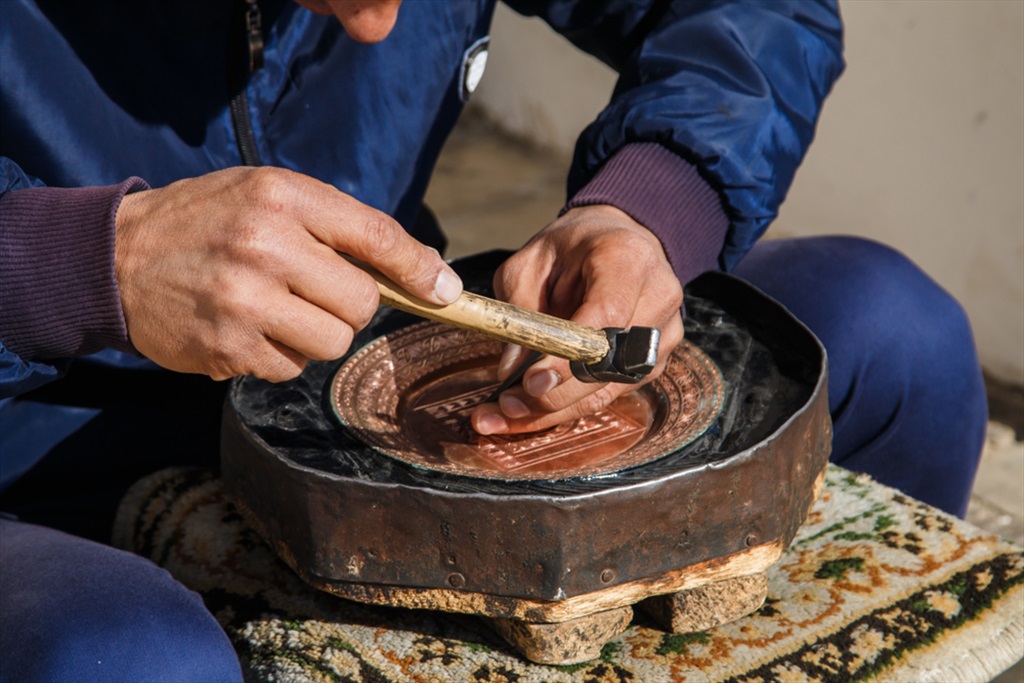Tire, one of the charming towns of Izmir, draws attention with its natural beauties, historical cultural values, delicious cuisine as well as productivity and richness in handicraft and arts. Weaving, quilt making and shoes are Tire's main crafts.
Tire, located on the slopes of the Gümü mountains and 90 kilometers from Izmir, is a town that deserves to be seen with its historical mosques, baths, inns, narrow streets, hundreds of years old trees, houses with windows and fruit trees. Tire's “Tire Meatballs”, roasted herbs, black mulberry cheese dessert and Aegean style appetizers are legendary. However, it is not only these features that make Tire famous. Tire is a district where handicrafts and arts are highly developed.
It is a great pleasure to visit Tire's bazaar, it has many places to explore. The colorful shops in historical inns and bazaars are dazzling. You wonder what to look at, what to examine. As you wander around, you realize with admiration that this small town is highly developed in weaving, quilt making and horseshoes.
Weaving that requires patience; Tire Beledi Weaving
Tire's famous weaving of Beledi is Turkey's oldest and one of the traditional cotton weaving. Beledi weavings, which date back to the 16th century, are woven on looms that can be controlled with 24 frames, 16 or 13 pedals. Normally looms consist of 2, 4 or 6 frames. Even so much information reveals how laborious Beledi weaving requires. The products emerging in these benches are known for being double-layered and very durable. The ground colors are green, red and dark blue upon request. Motif colors are in white and yellow. The width of the weavings is generally 60 cm. It has two types, "medium" and "ala". Silk is used very little in medium weaving, mostly upholstery quilts and mattress faces are woven. Ala-type weavings are made of silk, mostly curtains.
Although the weaving looms and shops are spread over the bazaar, some of them are located in the historical Tahtakale Bazaar. Tahtakale Bazaar, which has been open for 600 years with its eight domes and doors opening to four sides, is the first Ottoman bazaar plan. It is possible to find the famous felts, fabrics, silk curtains, covers and laces of the region in this bazaar.
The address of handcrafted quilts is Yorgancılar Street
Sleeping under the Atlas duvet is a tradition that has been around for years in Tire. Quilts made with rich motifs embroidered on satin fabrics in pastel or vibrant colors come to life with handcrafted made in the shops on Yorgancılar Street in Tire. Although their numbers are decreasing today, this historical street is still full of quilters. Even seeing elegant patterned quilts such as straw knitting, diamond, rose, shuttle, lemon seed is a great pleasure. Those who see it cannot stop without taking their pictures. Maybe they are a little heavier than the factory made fiber quilts that we are used to, but they are both much healthier and very well heated.
Colorful clogs, the symbol of Tire
The clogs of Tire, which are decorated with red, green and purple velvets, silvery ropes, wire breaks and scales, reflect the fine taste of Ottoman art. The clogs, which women did not take off their feet in palaces, mansions and baths for a while, became a cultural symbol in Tire. In the past, it was possible to understand the characteristics of the person who would wear it and the appearance of the clog. For example, the slightly embroidered eyebrows of the clogs were given to girls at the age of marriage, the heavily embroidered ones to the engaged girls, and those with heavily embroidered exhibition parts were given to the brides. Clogs, which were indispensable for dowry chests at that time, are nowadays preferred as exhibitions and ornaments. They deserve this with their fascinating images.
It is made of poplar and willow trees so that the Tire's Clogs is not affected when wet. In order to make clogs, trees to be made of clogs are cut and carved first. This process, which is now done with Hızar (wood saw), used to be done with a tool called the clog cutter. After the shaping process is completed, it's time to sand. Leashes made of truck tires are attached to the soles, which are sanded and cut into thin slices, and the skeleton of the clog is formed. However, the real work starts after that. Because Tire is famous for its ornaments. Decorations made by burning or carving technique in various regions are embroidered on velvet in Tire. Apart from hand skills, it also requires great patience. If you happen to be in Tire and wander around the old bazaar, do not forget to buy these special shoes.






Comments
No comment left, would you like to comment?